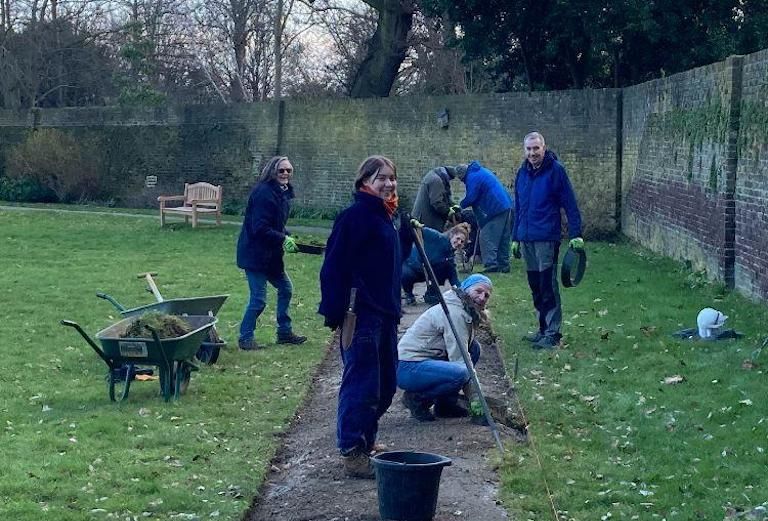
Written by garden volunteer George.
It’s not strictly gardening, I know – more like hard landscaping – but there are few jobs I enjoy more in the walled garden than maintaining the paths. Once upon a time, it would have been a simple matter of spraying the paths a couple of times a year with a weedkiller, most likely one based on two active ingredients – diflufenican and glyphosate. Diflufenican is an environmental contaminant, a xenobiotic, a herbicide and a carotenoid biosynthesis inhibitor. Glyphosate (IUPAC name: N-(phosphonomethyl) glycine) is a broad-spectrum systemic herbicide and crop desiccant.
I don’t think many of us would want to have much to do with either of these, (especially since some studies have linked glyphosate to cancer, liver and kidney damage)! Thankfully, Fulham Palace garden is now managed organically, without the use of either of these or any other pesticides or herbicides. So, path maintenance here at the Palace has to be done differently.

This is how we do it. First, collect the tools: hoe, edging shears, half-moon, hand fork, small border fork, springbok wire rake, rubber rake, riddle, black bucket for weeds, yellow bucket for ‘bad’ weeds. This may seem rather a lot of tools for a fairly simple operation, but each one has its use, as I shall explain.
If the path is adjacent to the lawn, the edge may need attention first. This may just be a run along with the edging shears, or if the edge is very overgrown, in places where there is no metal edge, the half-moon may be required to cut a new one. In either case, rake the debris off first, before you tackle the path itself.
The next step is to hoe the weeds which grow, as weeds inevitably do, along the path. Walk backwards as you work, keeping the hoe as nearly parallel to the ground as you can – hard on the back, but the best way to cut the weeds off without digging in too deep. I like to take a stretch of about 10 yards at a time. Most of the weeds are in the softer stuff at the edges of the path, but there is always an occasional small one nearer the harder middle, and it’s important to scrape these off too.
Now pick up the springbok and, with a light touch so that you don’t pick up too much of the path itself, rake off the weeds you have hoed. This operation will inevitably reveal some weeds that you have missed, and some of these will be deeper-rooted, dandelions, for example, or couch grass. This is where the hand fork, sometimes even the border fork, come into play – remembering always to put the couch into the ‘bad’ bucket, along with any other pernicious weeds, although few of these grow in the paths; no bindweed or Oxalis, for example.

Once you have raked off (with the springbok again) these final weeds you will have a pile of weeds and path material, and it’s time for the riddle. You could use a shovel to pick it all up, but I prefer using my hands (the gardener’s most important tools). Shake it through the riddle so that the sandy path material falls on the section you have hoed, then dump the remaining weeds in your bucket.
Almost finished, and now it’s time for the rubber rake. Work it first along the edge where you have hoed and disturbed the surface, leaving it smooth while maintaining the path’s camber. This is tricky; it requires a very light touch and may need several goes to get it right. Once both sides of the path have been done to your satisfaction, draw the rubber rake down the middle of the path in continuous sweeps to pick up any stray material and leave it looking neat – oh, and curse (under your breath) any colleague who then scuffs up your lovely finish or drops things on it!
That’s it. Simple enough, but not that easy to get right. And it’s hard to beat the satisfaction of standing up, easing your aching back and looking along a stretch of path that you have left looking perfect.
Now you know the process of caring for the paths at the Palace and all the hard work that goes into caring for them.
Interested in learning more about the Palace and what we’re doing to be as green as can be?